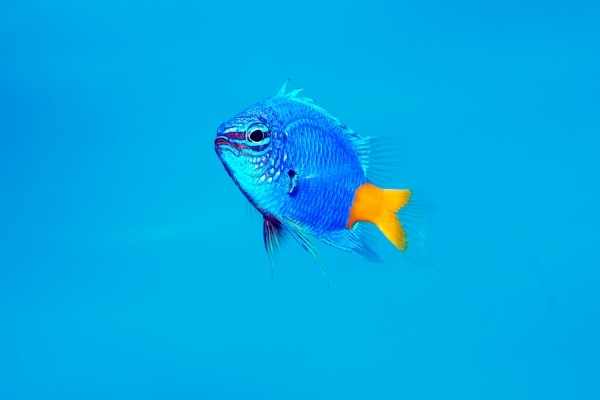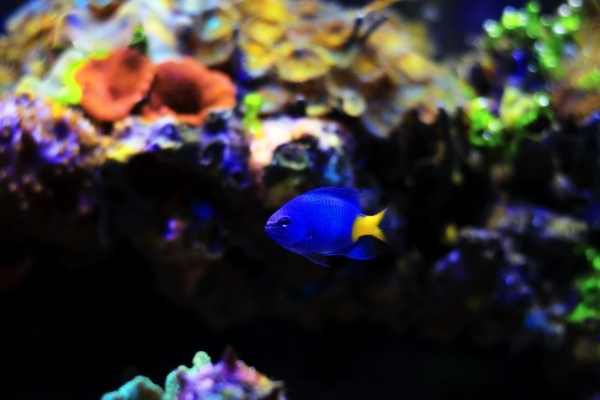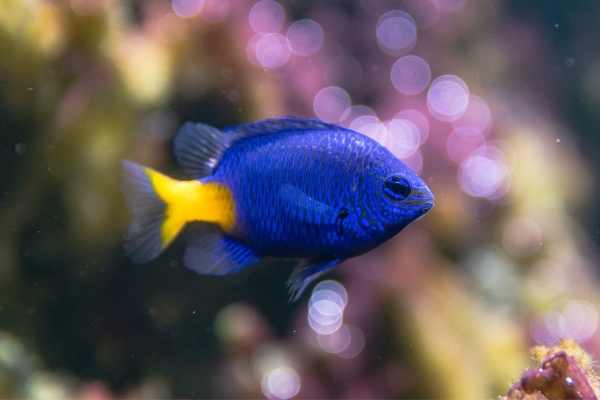[ad_1]
The Yellowtail Damselfish is one of the 20 most popular saltwater fish. They are extremely hardy, gorgeous, inexpensive, and available in aquarium shops everywhere. But while they are suitable for beginners, they are not always recommended for beginners. Let’s dive a little bit deeper into what makes this species both perfect for beginners AND a species that many of us would probably be best to avoid.
Table of Contents
Quick Facts About the Yellowtail Damselfish
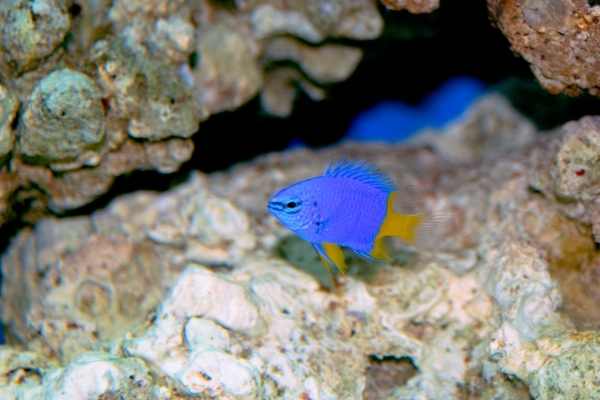
Yellowtail damselfish and live rock
- Scientific Name: Chrysiptera parasema
- Common Names: Yellowtail Blue Damsel, Goldtail Demoiselle, Yellowtail Damsel.
- Max Size: 2-3 inches, 5-7.5 cm
- Minimum tank Size: 20 Gallons, larger is likely better to encourage more peaceful community behaviors and not exaggerate territoriality
- Aggression Level: Aggressive – territorial, incompatible with clownfish and will harass mild-mannered fish
- Color: Blue, Yellow
- Care Level: Easy–these hardy fish are suitable for aquarium owners of all skill levels–with special consideration for their aggressiveness
- Reef safe: Yes
- Diet: Omnivorous–will eat small meaty and vegetable-based foods. Will likely be an extremely eager eater of anything offered at home
Natural habitat
The Yellowtail Damselfish is naturally found in areas of the Indian and Pacific oceans, around Japan, Australia, and the Philippines. They tend to be associated with thriving, high-density coral reefs, but can also be found in lagoons and inshore reefs. Chrysiptera parasema is a territorial fish that will squabble with neighbors and often finds itself on the menu of larger saltwater fish.
Ideal aquarium conditions and care requirements
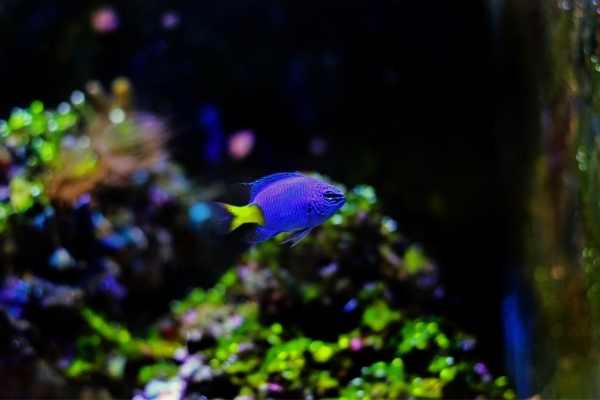
note the algae in the background here, this is either a new aquarium or one struggling to keep parameters tight
While this species is inexpensive, hardy, and tolerant of less-than-perfect aquarium conditions, that shouldn’t be considered permission for us not to try and meet their preferred husbandry requirements. As is the case with nearly all tropical reef fish that we care for, they tend to do best when the conditions in our saltwater tanks match that of the reefs:
- Temperature: high 70s to low 80s Fahrenheit
- Salinity: 1.025 specific gravity (can be lower, if kept in a fish-only tank)
- pH: 8.1 – 8.4
- Ammonia, Nitrites, Nitrates: 0 parts per million (ppm) is ideal.
Admittedly, the Yellowtail Damselfishes are tolerant of moderately high levels of nitrates that will cause problems for the other animals under your care before it stresses them too much, but having high nitrates in your tank isn’t good for anyone.
Learn more about reef quality water or how to choose the right salt mix
Since they are a relatively smaller saltwater aquarium fish species and only reach a maximum size of about 3 inches, you don’t need a lot of room to keep them. 20-gallons is probably pushing the limit a bit, on the small size, only if kept with other small aggressive fish (like maybe a few damselfish, for example).
If you want to keep them as part of a community tank, the larger the tank, the better, because having more territory to share and defend may dilute the aggression a bit.
When setting up the aquarium for a Yellowtail Damselfish, you don’t need to worry about the type of substrate or water flow. They will be fine with a bare bottom tank, sandy bottom, or even coarse coral or rubble substrate. They can also tolerate low or high water flow.
The one thing all saltwater fish need, to feel secure in a home saltwater tank is structure, like live rock, so that they can have a safe place to retreat to when threatened. For more info about live rock, check out this definitive guide.
Aquarium decorations will also suffice if that’s the look you’re most interested in, or you could even use something utilitarian like PVC pipe sections, too. Any structure that won’t contaminate the water that provides some things to ‘break up’ the water/pattern and provides a shelter will do nicely.
If this is a fish-only aquarium you can also save some money and get inexpensive LED lights. This is a great option if this is your first foray into saltwater and you aren’t ready for the big equipment expense and commitment.
Aggression
The Yellowtail Damselfish is an aggressive saltwater fish–some would say semi-aggressive, but in my experience, they will defend their territories from interlopers, which essentially is any other fish that wants to swim around the tank :).
If your goal is to have a peaceful community tank, it is generally best to avoid aggressive fish–however, the allure of these blue and yellow jewels can sometimes be too much for us to avoid. If you must have a damselfish in your tank, here are some ways to help minimize trouble:
Add your Yellowtail Damselfish to the tank last–after every other fish has had a chance to acclimate and stake their claim to a territory in the tank. The absolute worst thing you can do is add this fish to live cycle your tank. Conditions in a pre-cycled tank are harsh–it’s mean to do to any living thing–but even if your fish survives cycling, it will then stake claim to the entire volume of the tank. Yikes.
Learn more about dealing with aggression here.
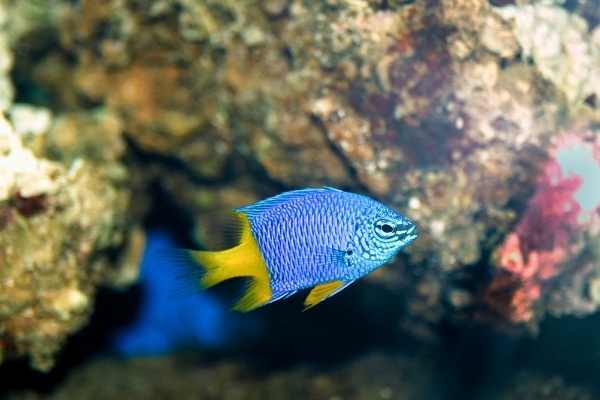
Chrysiptera parasema is one of the most popular saltwater fish for a reason
Compatibility
Due to their territoriality, the Yellowtail Damselfish won’t be compatible with many of the other saltwater aquarium fish you might otherwise hope to keep them with. Think of them as African Cichlids on steroids…hahaha.
As is the case with African Cichlids, sometimes the best solution to the aggression is to keep them with a tank full of other similarly aggressive species, like Blue Devil Damselfish, Domino Damselfish, etc.
When trying to make aggressive fish compatible with each other–the more the merrier. Aggression between fish becomes an issue when one individual or the other gets picked on and harassed to the point where they become stressed, injured, sick, and/or malnourished. Believe it or not, the problem becomes less of a problem when the aggression is spread out among a shoal of different fish. In that way, no one or two (unless they become sick…) gets terrorized.
The Yellowtail Damselfish is not compatible with:
Possibly compatible partners may include:
Spawning and reproduction
In keeping with the comparisons with cichlids, Matthew Wittenrich reports that spawning is relatively easily accomplished with the Yellowtail Damselfish and other blue damsels. The species does exhibit sexual dimorphism, with mature males being larger than females, and with females taking on more of a rounded belly appearance (Wittenrich 2007).
Expect aggression, when trying to create a pair.
Fish tend to spawn best, when fed a conditioning diet that is high in calories and more ‘whole food’ or even living in content–live blackworms are one of my absolute favorite fish foods, live or frozen mysis shrimp, brine shrimp, and even special seafood blends would all get these not-so-picky eaters fattened up for the calorically ‘expensive’ breeding attempts.
They are demersal spawners, which means they will attach their eggs to a substrate, like clownfish and cichlids. In your community reef tank that might be live rock, a decoration, or even the sidewall glass. If kept in a tank dedicated to spawning, that might mean a PVC pipe, flower pot, or ceramic tile.
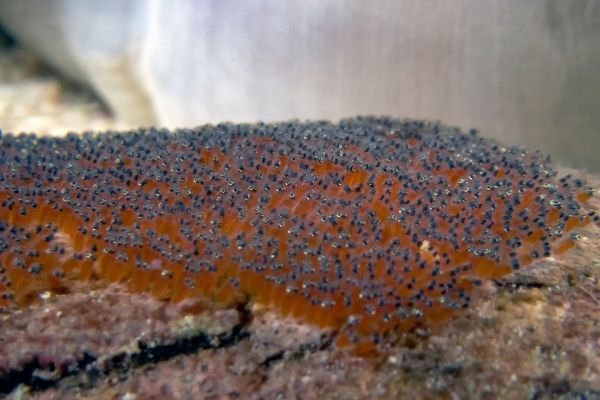
Demersal spawners, like Yellowtail Damselfish, lay eggs attached to the substrate. Broadcast spawners scatter floating eggs
Once spawning is initiated and becomes routine, a pair should spawn more often than every two weeks (perhaps around every 10 days), with eggs hatching about half-way through (about every 5 days), although this is likely influenced by the temperature (lower = slower, warmer = faster).
Getting them sufficient nutrition early on and through metamorphosis is the tricky part. While spawning is reportedly easy to achieve, caring for them through metamorphosis is not. The lack of abundantly available aquacultured individuals is partial evidence of that (likely also suppressed by the low, low price.
To learn more about breeding saltwater fish, check out my favorite books.
Feeding
These are bold eaters, potentially even aggressive. They will accept nearly anything you feed your tank, from flakes, pellets, frozen foods. Since they are omnivores, it is likely best to vary the types of foods periodically to enable nutrition from multiple food types, including some with plant sources.
Learn more about damselfish
If you have a few more minutes and want to learn more about a community tank appropriate damselfish, check out these:
Conclusions
Are you torn about whether or not to add the Yellowtail Damselfish to your reef tank? I know the feeling. In some ways, they are the perfect saltwater fish. To be fair, they are likely one of the most well-suited to life in a home aquarium. It’s just their territoriality and aggression which can make them a bit challenging to keep. Aggression is a real issue with them and they may terrorize some of your more delicate and expensive other tank mates.
Who are they best for? The Yellowtail Damselfish is best for someone new to the saltwater aquarium hobby, who wants to prove to themselves that they have what it takes to keep a saltwater fish happy and healthy. They are also a great option for those of us looking to keep the costs down a bit (this hobby can get insanely expensive). Finally, they are best for those who love Damselfishes and are okay with limiting their options for a few years.
They are also a great option for a species-specific tank and for you to practice breeding and rearing saltwater fish.
They are not a fish that should be used to live-cycle a tank (read more about properly cycling a tank here). And they are not for anyone who hopes to one day keep some of the more docile and shy saltwater fish species.
Have you had the Yellowtail Damselfish in your tank? What has your experience been? Please leave a comment below and let us know what you observed and/or any tips you have. Thanks!
Recommendations on what to read next
Check out these other great Saltwater fish profiles and care guides:
- Yellow longnose butterflyfish
- Pyjama cardinalfish
- Bicolor angelfish
Check out this definitive guide on how to set up a saltwater aquarium too.
Works cited
Michael, Scott W. Marine Fishes: 500+ Essential-to-know-aquarium-species. TFH Publications. Neptune City, NJ 2001.
Wittenrich, Matthew L. The Complete Illustrated Breeder’s Guide to Marine Aquarium Fishes. TFH Publications. Neptune City, NJ. 2007
[ad_2]
Source link

